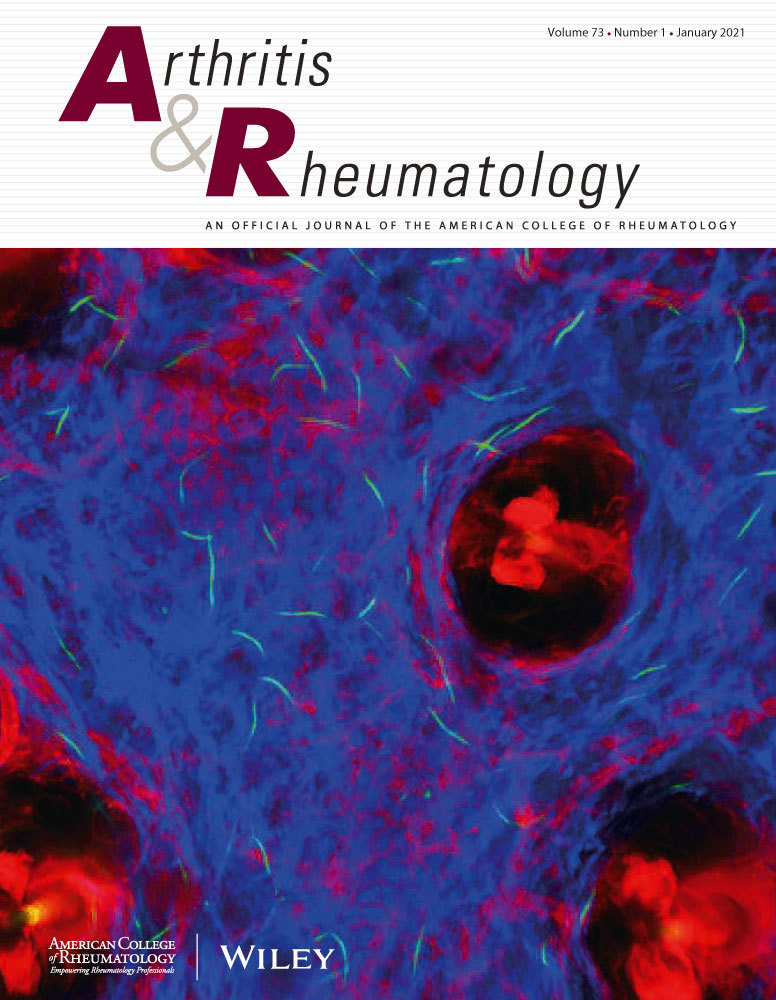类风湿关节炎相关间质性肺疾病或支气管扩张患者严重感染的风险:一项比较队列研究
IF 10.9
1区 医学
Q1 RHEUMATOLOGY
引用次数: 0
摘要
目的探讨类风湿关节炎相关性肺部疾病(RA-LD)与严重感染风险的关系。方法:我们使用MGB生物银行(波士顿,马萨诸塞州)进行了一项回顾性队列研究,比较RA-LD和无肺部疾病(RA-no -LD)的RA患者,按年龄、性别和RA持续时间匹配。RA-LD病例通过病历回顾和临床明显ra相关性间质性肺病(RA-ILD)和/或ra相关性支气管扩张(RA-BR)的胸部影像学检查得到证实。主要结局为严重感染。使用Fine和Gray模型计算发病率和倾向评分调整后的亚分布风险比(sdHR),以解释竞争死亡风险。结果在221例RA-LD病例(151例RA-ILD和70例RA-BR)和980例RA-no -LD比较组中,RA-LD的严重感染风险明显高于RA-no -LD比较组(55.8 vs 25.8 / 1000人年,sdHR 1.60, 95%CI 1.20-2.12)。RA-ILD病例的风险增加仍然显著(sdHR 1.79, 95%CI 1.33-2.41),但RA-BR病例的风险增加不显著(sdHR 1.19, 95%CI 0.72-1.97)。RA-LD最常见的感染解剖部位包括肺部、皮肤软组织和耳鼻喉;RA-LD与多种病原体类型相关:病毒、细菌、真菌和分枝杆菌。在RA-LD病例中,特别是RA-BR病例中出现频率较高的特定病原体包括流感病毒、呼吸道合胞病毒、葡萄球菌、假单胞菌和非结核分枝杆菌。结论ra - ld,尤其是RA-ILD,与不同解剖部位和不同病原体类型的严重感染风险显著增加相关。RA-BR与肺部感染增加有关。需要前瞻性研究和试验来明确治疗RA-LD患者和降低感染风险的最佳方法。本文章由计算机程序翻译,如有差异,请以英文原文为准。
Risk of serious infection in patients with rheumatoid arthritis-associated interstitial lung disease or bronchiectasis: A comparative cohort study.
OBJECTIVE
To investigate the association between rheumatoid arthritis-associated lung disease (RA-LD) and serious infection risk.
METHODS
We conducted a retrospective cohort study using the MGB Biobank (Boston, Massachusetts), comparing RA-LD to RA patients without lung disease (RA-no LD), matched by age, sex, and RA duration. RA-LD cases were verified by medical record review and chest imaging for clinically apparent RA-associated interstitial lung disease (RA-ILD) and/or RA-associated bronchiectasis (RA-BR). The primary outcome was serious infection. Incidence rates and propensity score-adjusted subdistribution hazard ratios (sdHR) were calculated using Fine and Gray models to account for competing risk of death.
RESULTS
Among 221 RA-LD cases (151 RA-ILD and 70 RA-BR) and 980 RA-no LD comparators, RA-LD had a significantly higher serious infection risk compared to RA-no LD comparators (55.8 vs. 25.8 per 1,000 person-years, sdHR 1.60, 95%CI 1.20-2.12). The increased risk remained significant for RA-ILD cases (sdHR 1.79, 95%CI 1.33-2.41), but not for RA-BR (sdHR 1.19, 95%CI 0.72-1.97). Anatomic sites of infection that were more common in RA-LD included pulmonary, skin and soft tissue, and ear, nose and throat; RA-LD was associated with various pathogen types: virus, bacteria, fungus, and mycobacteria. Specific pathogens with higher frequency in RA-LD cases, particularly among RA-BR, included influenza virus, respiratory syncytial virus, Staphylococcus, Pseudomonas, and nontuberculous mycobacteria.
CONCLUSION
RA-LD, particularly RA-ILD, is associated with a significant increased risk of serious infection across anatomic sites and diverse pathogen types. RA-BR is associated with increased pulmonary infections. Prospective studies and trials are needed to clarify optimal approaches to treat patients with RA-LD and reduce infection risk.
求助全文
通过发布文献求助,成功后即可免费获取论文全文。
去求助
来源期刊

Arthritis & Rheumatology
RHEUMATOLOGY-
CiteScore
20.90
自引率
3.00%
发文量
371
期刊介绍:
Arthritis & Rheumatology is the official journal of the American College of Rheumatology and focuses on the natural history, pathophysiology, treatment, and outcome of rheumatic diseases. It is a peer-reviewed publication that aims to provide the highest quality basic and clinical research in this field. The journal covers a wide range of investigative areas and also includes review articles, editorials, and educational material for researchers and clinicians. Being recognized as a leading research journal in rheumatology, Arthritis & Rheumatology serves the global community of rheumatology investigators and clinicians.
 求助内容:
求助内容: 应助结果提醒方式:
应助结果提醒方式:


